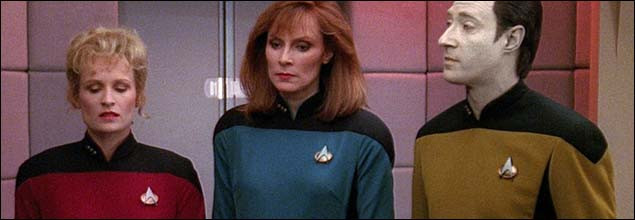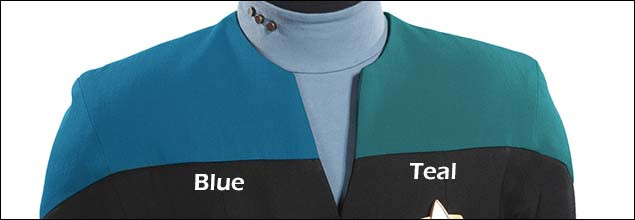Uniforms are more than just clothing; they are powerful visual cues that communicate roles, ranks, and affiliations. In the Star Trek universe, the different colored uniforms instantly tell you about a crew member’s primary area of expertise. While these colors offer a quick guide, the reality is often more nuanced, especially on a diverse starship crew. Let’s delve into what the colors of uniforms mean in Star Trek, using the iconic uniforms from Star Trek: Voyager as a prime example.
The uniforms most prominently featured in Star Trek: Voyager are known as the Standard Duty Uniforms (SDU). Introduced in 2369, these were the standard Starfleet attire when Voyager embarked on its ill-fated mission, getting stranded in the distant Delta Quadrant nearly two years later. These uniforms, like their predecessors from Star Trek: The Next Generation (TNG), utilize a color-coded system to denote division.
 Star Trek Voyager uniforms displaying different division colors
Star Trek Voyager uniforms displaying different division colors
Here’s a breakdown of the division colors used in the TNG-era SDUs:
- Red: Command and Starship Operations. This color is typically worn by commanding officers like Captains and those in navigation and helm control.
- Gold/Yellow: Security, Engineering, and Operations. This division includes roles vital for the ship’s functionality and safety.
- Blue: Sciences and Medical. This color represents those in research, science, and healthcare fields.
Despite being phased out in 2371 by Starfleet in favor of a more streamlined design, the Voyager crew continued to wear the SDU style throughout their seven-year journey home. This was a practical necessity due to their isolation from Starfleet resupply and support. The SDU design inverted the color distribution compared to the earlier TNG two-piece uniforms. Instead of a colored top with black shoulders, the SDU featured a black top with colored shoulders and collar, minimizing the colored area. This trend of minimizing color continued with the Dominion War-era jumpsuit uniforms, first seen in Star Trek: First Contact and later in Star Trek: Deep Space Nine (DS9).
Note on Color Perception: It’s worth noting that the Sciences division color, while officially blue (a deep sapphire), can sometimes appear teal or even green depending on lighting and individual perception. This variation is important for viewers to consider when interpreting uniform colors.
Uniform Colors and Dual Roles: More Than Meets the Eye
The color of a Starfleet uniform primarily indicates the wearer’s assigned division based on their primary role. However, it’s crucial to understand that this color doesn’t limit an individual’s skills or duties. Many Starfleet officers are capable of performing tasks outside their primary specialization. For instance, a crew member assigned to the Sciences division, and therefore wearing blue, might be an expert in computer technology and frequently assist in Engineering. Their uniform remains blue because their official designation is within the Sciences Division.
On Voyager, where resources and personnel were limited, the need for versatility was even more pronounced. Lieutenant Tom Paris, for example, wears a red uniform as the ship’s helmsman and a member of the Operations division. However, he also possesses deep knowledge in aerodynamics and warp field theory, often contributing to scientific and engineering challenges. Captain Kathryn Janeway, in her red Command uniform, is another excellent example. While her role is command-focused, her background is rooted in physics and science. Before commanding USS Billings, she served as a Science Officer, showcasing her extensive scientific expertise.
 Captain Janeway and Commander Chakotay in their Starfleet uniforms on the bridge of USS Voyager
Captain Janeway and Commander Chakotay in their Starfleet uniforms on the bridge of USS Voyager
This highlights a key aspect of uniform meaning: they represent the organizational structure and primary responsibilities within Starfleet, but not the entirety of an individual’s capabilities. Especially in environments like a starship, cross-functional skills are essential, and uniforms provide a framework for understanding general roles while acknowledging individual versatility.
Alternate Uniform Colors and Shifting Meanings
Interestingly, the color-coding wasn’t always consistent across all Star Trek series. In Star Trek: The Original Series (TOS), the colors for Command and Operations were reversed. Command officers wore gold uniforms, while Operations/Engineering personnel wore red. TOS also introduced a Captain’s tunic variant that appeared light green with gold sleeve braids, further demonstrating slight variations in uniform protocols even within the same era.
Furthermore, the concept of uniform color meaning is sometimes deliberately altered in storylines involving alternate timelines or realities. In the TNG episode “Parallels,” Lieutenant Worf is seen wearing different uniform colors across various parallel realities, including red and gold, highlighting the shifting nature of identity and role in those altered universes. Similarly, in “Tapestry,” Captain Picard experiences an alternate reality where he is a junior officer in Sciences, wearing a blue uniform, a stark contrast to his usual red Command attire. Another intriguing example is Voyager’s Doctor. When activating his Emergency Command Hologram (ECH) subroutines, his standard blue Sciences uniform transforms into a red Command uniform, visually representing his temporary shift into a command role.
 The Doctor activating his Emergency Command Hologram and changing uniform color
The Doctor activating his Emergency Command Hologram and changing uniform color
These instances of color variation and alteration serve to emphasize that while uniforms communicate a standard set of meanings, those meanings can be context-dependent and even intentionally manipulated for narrative purposes.
Color Inconsistencies: Blue vs. Teal and Visual Perception
Finally, when discussing uniform colors, particularly within the TNG era, it’s important to acknowledge real-world inconsistencies in how colors were depicted on screen. The Sciences division color, intended to be a deep sapphire blue, often appeared as more of a teal shade. Side-by-side comparisons reveal these subtle but noticeable differences. These variations likely stem from inconsistencies in fabric dyes or lighting conditions during filming. However, for viewers with certain types of color vision deficiency, such as blue-yellow tritanopia, distinguishing between these shades of blue, or even perceiving the teal as green, can be challenging. Darker lighting conditions could further exacerbate this perception, making the teal variant appear greener than intended.
In conclusion, Star Trek uniforms, particularly the color-coded system, offer a fascinating case study in the meaning and symbolism of uniforms. While the colors primarily indicate a crew member’s main division and role, they don’t define the limits of their abilities. Variations in color depiction, both intentional and unintentional, further enrich the visual language of uniforms within the Star Trek universe, prompting viewers to consider the multifaceted nature of identity and function conveyed through what characters wear.
